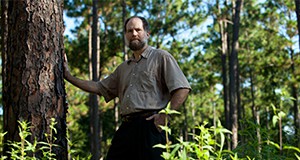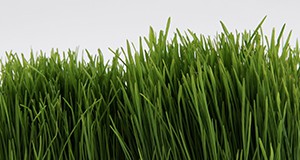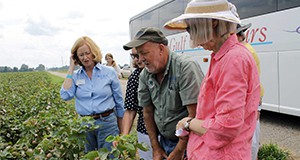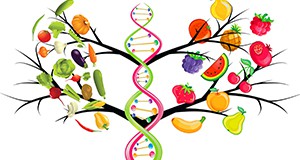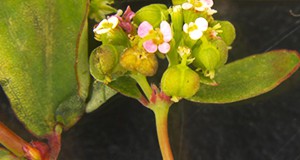
A new and innovative approach to Best Management Practices for fertilizer application known as 4R nutrient stewardship is available, to ensure the environmental, social, and economical sustainability of commercial crop production. This 3-page fact sheet focuses on the basic concepts of the 4R nutrient stewardship principles for commercial crop production. Written by Guodong Liu, Kelly Morgan, Yuncong Li, Lincoln Zotarelli, James DeValerio, and Qingren Wang, and published by the UF Department of Horticultural Sciences, July 2015.
http://edis.ifas.ufl.edu/hs1264
Category: Agriculture
Getting the Most out of Social Media

Agriculturalists can use social media as a powerful tool for marketing their products and establishing a brand identity. The goal of this series is to help agriculturalists understand how social media can work for them. The series also discusses the various social media platforms and how to use social media strategically and wisely. Written by Jessica C. Fernandez and Joy N. Rumble, and published by the UF Department of Agricultural Education and Communication, August 2015. (Photo credit: tanuha2001/iStock/Thinkstock.com)
http://edis.ifas.ufl.edu/topic_series_getting_the_most_out_of_social_media
HOT TOPIC: Oriental Fruit Fly
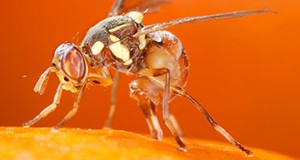
On Tuesday September 15th 2015, Florida Commissioner of Agriculture Adam H. Putnam declared a state of agricultural emergency due to the oriental fruit fly infestation in Miami-Dade County. The oriental fruit fly is considered one of the most serious of the world’s fruit fly pests due to its potential economic harm. For general information on this destructive pest of fruit, see EENY-083: Oriental Fruit Fly, Bactrocera dorsalis (Hendel) (Insecta: Diptera: Tephritidae) an informative Featured Creatures fact sheet describing the species, its distribution, life history, hosts, damage, quarantine & management, and selected references. (Photo Credit: Scott Bauer, USDA)
Also see these useful sources for news and information on the emerging threat:
Economic Contributions of Agriculture, Natural Resources, and Food Industries in Florida in 2013
About 1.52 million people worked full- or part-time in Florida’s agriculture, natural resources and food industries in 2013– an 8.7 percent increase in jobs over 2012.
Recognizing the significant impact agriculture, natural resources, and related food industries have on the economy of Florida is essential to informed public policy. UF/IFAS researchers used the Implan regional economic modeling system to estimate economic multipliers for over 500 different industry sectors and evaluate their economic contributions in 2013. This 5-page executive summary was written by Alan W. Hodges, Mohammad Rahmani, and Thomas J. Stevens and published by the Department of Food and Resource Economics, September 2015. (UF/IFAS File photo)
http://edis.ifas.ufl.edu/fe969
Related Resources:
Press release: http://news.ifas.ufl.edu/2015/09/floridas-agriculture-related-employment-up-8-7-percent/
Full report: http://fred.ifas.ufl.edu/pdf/FE969-FullReport.pdf
Turfgrass Herbicides: Mechanisms of Action and Resistance Management
Herbicides are an effective tool for controling weeds in turfgrass; however, weeds can become resistant to herbicides and create significant problems for turfgrass production. The best way to combat herbicide resistance is to rotate herbicides with different mechanisms of action (MOA) because using herbicides with different MOAs makes it more likely that weeds resistant to one herbicide will encounter an herbicide to which they are not resistant. This 4-page fact sheet focuses on how to create an herbicide program that uses different MOAs to manage resistant weeds. Written by Ramon G. Leon and Bryan Unruh, and published by the UF Department of Agronomy, August 2015.
http://edis.ifas.ufl.edu/ag398
Planning for a Farm Tour: Keeping the Conversation Fresh
Hosting tours at your farm can be a great way to market your products and your farm’s brand. Tours let you tell potential customers how you grow your food, why they should buy it, and who you are as a farmer. This 3-page fact sheet discusses these topics and provides logistical advice for planning and executing a successful farm tour. Written by Claire Mitchell and Joy N. Rumble, and published by the UF Department of Agricultural Education and Communication, August 2015.
http://edis.ifas.ufl.edu/wc219
Eight Steps to Developing a Simple Marketing Plan

Marketing is an essential component of any business, including agriculture. Despite the important role of marketing, many smallholding operators/growers are reluctant to create a marketing plan. This 5-page fact sheet provides a rationale for developing a marketing plan, a step-by-step process for creating one, and a marketing plan worksheet. Written by Edward A. Evans and Fredy H. Ballen, and published by the UF Department of Food and Resource Economics, August 2015. (Photo credit: iStock/Thinkstock)
http://edis.ifas.ufl.edu/fe967
Weed Management in Sesame
 Sesame is a promising new crop for Florida, but few herbicides have been registered for it as yet. This 2-page fact sheet provides weed-control strategies for sesame. Written by Jason Ferrell and Ramon Leon, and published by the UF Department of Agronomy, June 2015. (Photo credit: Doug Mayo)
Sesame is a promising new crop for Florida, but few herbicides have been registered for it as yet. This 2-page fact sheet provides weed-control strategies for sesame. Written by Jason Ferrell and Ramon Leon, and published by the UF Department of Agronomy, June 2015. (Photo credit: Doug Mayo)
http://edis.ifas.ufl.edu/ag396
Plant Diagnostic Clinic and HLB Lab
The Plant Pathology program at the UF/IFAS Southwest Research and Education Center is the state and local resource for plant diagnostic services, including HLB (Huanglongbing, or citrus greening) detection, and for insect identification. This brochure covers the center’s history, instructions for sending samples to the HLB lab, answers to frequently asked questions, and center hours and contact information. Written by Pamela Roberts, Shea Teems, Joubert Fayette, and Jamie Burrow, and published by the UF Department of Plant Pathology, July 2015.
http://edis.ifas.ufl.edu/pp319
Field Observations During the Eleventh Microwave Water and Energy Balance Experiment (MicroWEX-11) from April 25 through December 6, 2012
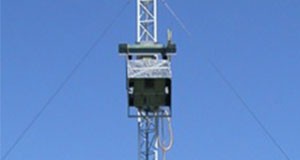 This new report from UF/IFAS researchers provides another set of observation data that can be used to develop better models for accurate prediction of weather and near-term climate. It describes the observations conducted during the MicroWEX-11, a season-long experiment incorporating active and passive microwave observations for bare soil, elephant grass, and sweet corn using a variety of sensors to understand land–atmosphere interactions and their effect on observed microwave signatures. These observations match that of satellite-based passive microwave radiometers and NASA’s recently launched Soil Moisture Active Passive (SMAP) mission. This 96-page report was written by Tara Bongiovanni, Pang-Wei Liu, Karthik Nagarajan, Daniel Preston, Patrick Rush, Tim H.M. van Emmerik, Robert Terwilleger, Alejandro Monsivais-Huertero, Jasmeet Judge, Susan Steele-Dunne, Roger De Roo, Ruzbeh Akbar, Ella Baar, Max Wallace, and Anthony England and published by the UF Department of Agricultural and Biological Engineering, July 2015.
This new report from UF/IFAS researchers provides another set of observation data that can be used to develop better models for accurate prediction of weather and near-term climate. It describes the observations conducted during the MicroWEX-11, a season-long experiment incorporating active and passive microwave observations for bare soil, elephant grass, and sweet corn using a variety of sensors to understand land–atmosphere interactions and their effect on observed microwave signatures. These observations match that of satellite-based passive microwave radiometers and NASA’s recently launched Soil Moisture Active Passive (SMAP) mission. This 96-page report was written by Tara Bongiovanni, Pang-Wei Liu, Karthik Nagarajan, Daniel Preston, Patrick Rush, Tim H.M. van Emmerik, Robert Terwilleger, Alejandro Monsivais-Huertero, Jasmeet Judge, Susan Steele-Dunne, Roger De Roo, Ruzbeh Akbar, Ella Baar, Max Wallace, and Anthony England and published by the UF Department of Agricultural and Biological Engineering, July 2015.
http://edis.ifas.ufl.edu/ae514
Using Airlifts to Collect and Concentrate Copepod Nauplii

Airlifts are simple and inexpensive and not new to aquaculture. The buoyancy of rising bubbles within a pipe or tube generates an upward flow of water that are often used as part of water treatment design in recirculating aquaculture systems, but can also be used to collect and concentrate live food organisms fed to marine fish larvae. Airlifts are more gentle and efficient than sieving. This 3-page fact sheet provides protocols and designs for harvesting and feeding copepod nauplii to marine fish larvae, but these methods can be adapted for use with many live feed organisms. Written by Eric Cassiano, Matthew DiMaggio, Cortney Ohs, and John Marcellus, and published by the UF Department of Fisheries and Aquatic Sciences, May 2015. (Photo credit: Jason S. Broach)
http://edis.ifas.ufl.edu/fa188
Phytophthora Identification and Sampling in Citrus Nurseries
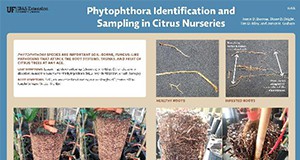
Phytophthora species are important soil-borne, fungus-like pathogens that attack the root systems, trunk, and fruit of citrus trees at any age. The front of this identification sheet includes images of healthy and infested roots and descriptions of leaf and root symptoms. The back lists sampling procedures: soil collection, soil testing, and diagnosing phytophthora. Written by Jamie D. Burrow, Diane B. Bright, Tim D. Riley, and James H. Graham, and published by the UF Department of Soil and Water Science, July 2015.
http://edis.ifas.ufl.edu/ss645
Postbloom Fruit Drop (PFD) Identification and Management
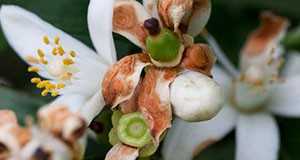
This two-sided ID card is idea for growers working in the field trying to identify or manage postbloom fruit drop (PFD) in citrus. The ID card includes photos of blooms affected by PFD and photos of healthy blooms for comparison. The card also includes facts and tips for managing PFD. Written by Megan M. Dewdney, Natalia A. Peres, and Jamie D. Burrow, and published by the UF Department of Plant Pathology, July 2015.
http://edis.ifas.ufl.edu/pp318
Fungal Gummosis in Peach
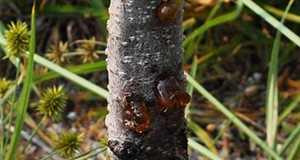
Fungal gummosis in peach occurs when the fungus Botryosphaeria dothidea infects small openings or wounds in tree branches or trunks. The disease causes blisters on the tree that form lesions and eventually ooze gum (sap). This 3-page fact sheet covers the disease cycle and management of fungal gummosis in peach, which is often difficult to control. Written by Sara Sherman, Mercy Olmstead, Philip Harmon, and Thomas Beckman, and published by the UF Department of Horticultural Sciences, July 2015.
http://edis.ifas.ufl.edu/hs1265
Peach Rust
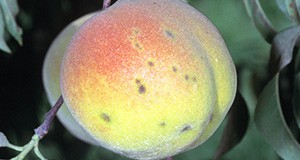
Peach rust is a fungal disease that affect the leaves and, less commonly, twigs and fruit of peach trees. The fungus that causes peach rust thrives in Florida’s humid climate and may cause significant economic losses in severely affected orchards. This 5-page fact sheet details peach rust symptoms, disease cycle, and management, including fungicide treatments. Written by Courtney Ligon, Mercy Olmstead, and Phillip Harmon, and published by the UF Department of Horticultural Sciences, June 2015.
http://edis.ifas.ufl.edu/hs1263
Biology and Management of Graceful Sandmat (Chamaesyce hypericifolia) in Ornamental Crop Production
Graceful sandmat (Chamaesyce hypericifolia) is a problematic weed that often grows in container media in ornamental plant nurseries. This 4-page facts sheet profiles the biology of graceful sandmat and recommends physical, cultural, and chemicals methods for managing the weed in the nursery environment. Written by Theresa Chormanski, Chris Marble, and Lyn Gettys, and published by the UF Department of Environmental Horticulture, June 2015.
http://edis.ifas.ufl.edu/ep522
Vespiform Thrips Franklinothrips vespiformis Crawford (Insecta: Thysanoptera: Aeolothripidae)
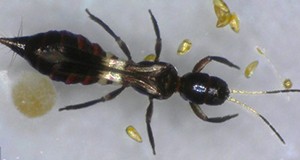
Franklinothrips vespiformis Crawford is a predatory thrips with a pantropical distribution. The distinctive red, humped-back larvae and fast-moving ant-like adults are predaceous on small arthropods. In addition to being easily mistaken for an ant, this beneficial thrips is unusual in that it constructs a silken cocoon within which it pupates. Males of this species are rare. This species is sold for use as a biological control agent in botanical gardens, zoos, interior landscapes, research greenhouses, nurseries with ornamental plants as well as outdoors in subtropical regions. This 4-page fact sheet was written by Runqian Mao, Yingfang Xiao, and Steven P. Arthurs, and published by the UF Department of Entomology and Nematology, March 2015. (Photo credit: Runqian Mao, UF/IFAS)
http://edis.ifas.ufl.edu/in1083
Black Scale Saissetia oleae (Olivier, 1791) (Insecta: Hemiptera: Coccoidea: Coccidae)
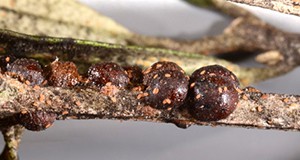 The black scale is an important pest of citrus and olive trees. Originally from South Africa, this scale is now distributed worldwide. In Florida, black scale is found on citrus, cultivated olive, avocado, and many popular landscape plants. It is likely that black scale, like many invasive pests, was imported to the United States on infested nursery plants. Based on their small size and the unique life history of scale insects, these insects are difficult to detect and control. This 4-page fact sheet was written by Morgan A. Byron, Jennifer L. Gillett-Kaufman, and Sandra A. Allan, and published by the UF Department of Entomology and Nematology, March 2015. (Photo credit: Lyle Buss, UF/IFAS)
The black scale is an important pest of citrus and olive trees. Originally from South Africa, this scale is now distributed worldwide. In Florida, black scale is found on citrus, cultivated olive, avocado, and many popular landscape plants. It is likely that black scale, like many invasive pests, was imported to the United States on infested nursery plants. Based on their small size and the unique life history of scale insects, these insects are difficult to detect and control. This 4-page fact sheet was written by Morgan A. Byron, Jennifer L. Gillett-Kaufman, and Sandra A. Allan, and published by the UF Department of Entomology and Nematology, March 2015. (Photo credit: Lyle Buss, UF/IFAS)
http://edis.ifas.ufl.edu/in1082
Black Turpentine Beetle, Dendroctonus terebrans (Olivier) (Insecta: Coleoptera: Curculionidae: Scolytinae)
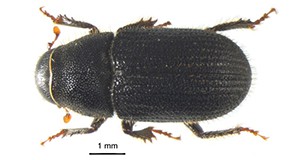 Black turpentine beetles bore into the inner bark of stressed or injured pines, where they breed and feed on phloem tissue. Adults are strongly attracted to volatile pine odors and readily breed in fresh stumps. In typical forests, infestations do not exhibit the rapid and devastating expansion characteristic of the closely related southern pine beetle, but in stands where stress conditions are frequent or persistent, black turpentine beetle can become a chronic pest and cause significant mortality over an extended period of time. Historically, black turpentine beetle has been a major pest of pines wounded or treated with herbicides in naval stores production. During the 1950s, black turpentine beetle damaged 37 million board feet of timber and contributed to the financial collapse of turpentine farms. This 5-page fact sheet was written by Albert E. Mayfield, John L. Foltz and Jiri Hulcr, and published by the UF Department of Entomology and Nematology, June 2015. (Photo credit Adam Black and Jiri Hulcr, UF/IFAS)
Black turpentine beetles bore into the inner bark of stressed or injured pines, where they breed and feed on phloem tissue. Adults are strongly attracted to volatile pine odors and readily breed in fresh stumps. In typical forests, infestations do not exhibit the rapid and devastating expansion characteristic of the closely related southern pine beetle, but in stands where stress conditions are frequent or persistent, black turpentine beetle can become a chronic pest and cause significant mortality over an extended period of time. Historically, black turpentine beetle has been a major pest of pines wounded or treated with herbicides in naval stores production. During the 1950s, black turpentine beetle damaged 37 million board feet of timber and contributed to the financial collapse of turpentine farms. This 5-page fact sheet was written by Albert E. Mayfield, John L. Foltz and Jiri Hulcr, and published by the UF Department of Entomology and Nematology, June 2015. (Photo credit Adam Black and Jiri Hulcr, UF/IFAS)
http://edis.ifas.ufl.edu/in636
An ambrosia beetle Xyleborus affinis Eichhoff, 1868 (Insecta: Coleoptera: Curculionidae: Scolytinae)
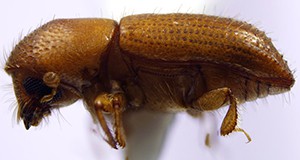 Xyleborus affinis is one of the most widespread and common ambrosia beetles in the world. It is also very common in Florida. Like other ambrosia beetles, it bores tunnels into the xylem of weakened, cut or injured trees and farms gardens of symbiotic fungus for food. Females lay eggs in the fungus-lined galleries and larvae feed exclusively on the fungi. Recent studies have shown that Xyleborus affinis can vector the fungus responsible for laurel wilt disease, which is lethal to numerous species of trees in the Lauraceae family. This 5-page fact sheet was written by Lanette Sobel, Andrea Lucky, and Jiri Hulcr, and published by the UF Department of Entomology and Nematology, June 2015. (Photo credit: Juri Hulcr, UF/IFAS)
Xyleborus affinis is one of the most widespread and common ambrosia beetles in the world. It is also very common in Florida. Like other ambrosia beetles, it bores tunnels into the xylem of weakened, cut or injured trees and farms gardens of symbiotic fungus for food. Females lay eggs in the fungus-lined galleries and larvae feed exclusively on the fungi. Recent studies have shown that Xyleborus affinis can vector the fungus responsible for laurel wilt disease, which is lethal to numerous species of trees in the Lauraceae family. This 5-page fact sheet was written by Lanette Sobel, Andrea Lucky, and Jiri Hulcr, and published by the UF Department of Entomology and Nematology, June 2015. (Photo credit: Juri Hulcr, UF/IFAS)
http://edis.ifas.ufl.edu/in1094
